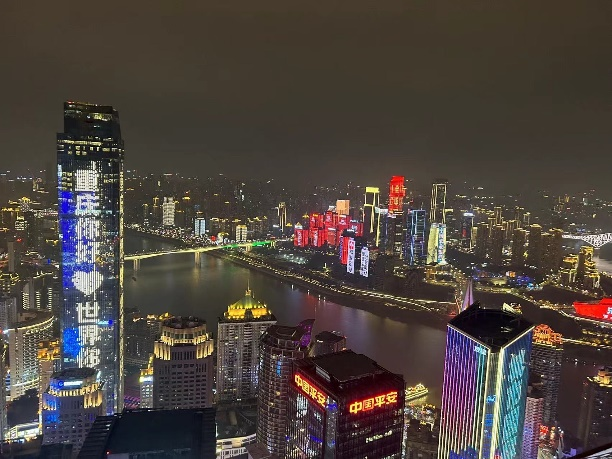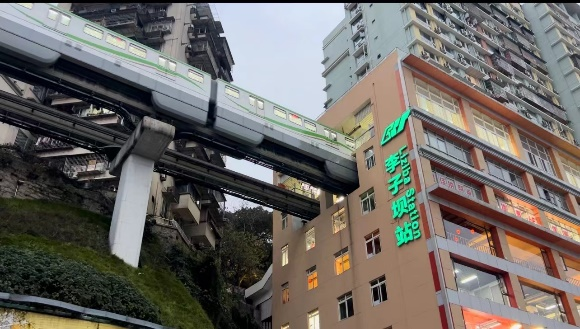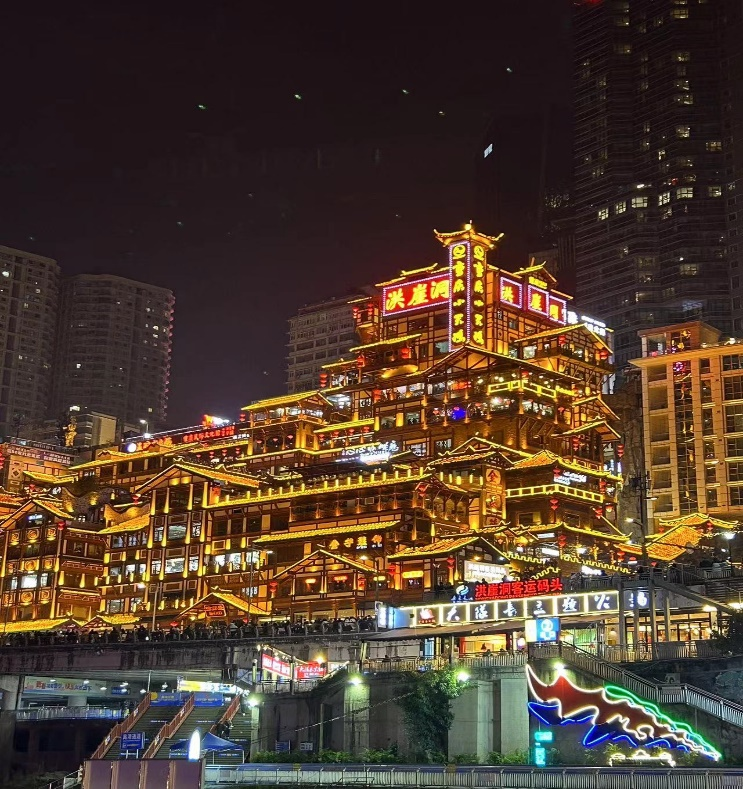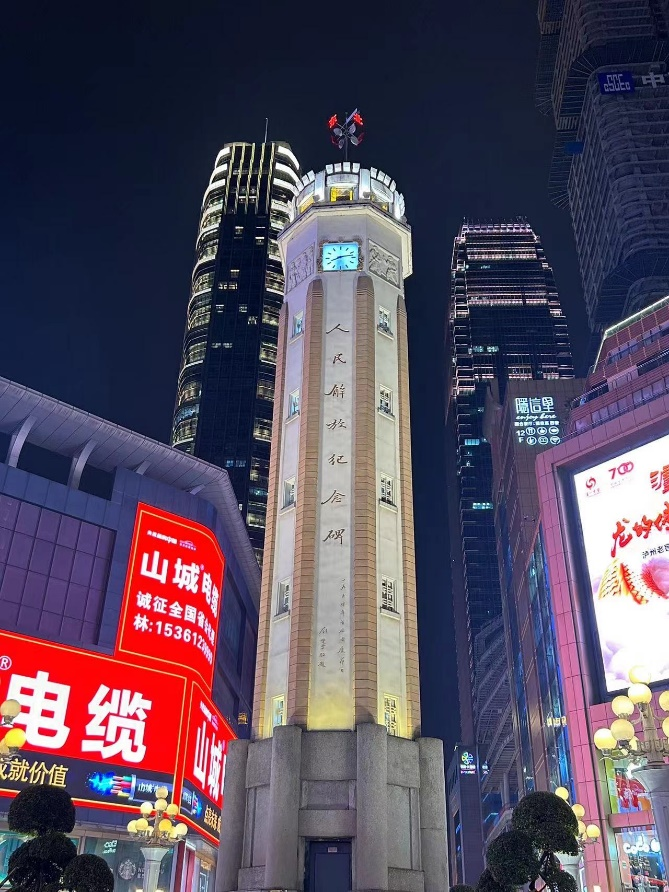
重庆夜景
Night Scenery of Chongqing
一.渝城记忆——现代
走进重庆是一场从三维世界到八维世界的跨越纵横交错的盘龙立交穿楼而过的李子坝轻轨横跨楼间的空中连廊重庆,生活在高低错落的空间里。当你感觉站在一楼时其实你在八楼。三千年的巴渝八百载重庆。这里,同时存在着过去和未来。
Entering Chongqing is a crossing from a three-dimensional world to an eight dimensional world, crisscrossing the Panlong overpass and passing through the buildings. The Liziba Light Rail spans the aerial corridor between the buildings in Chongqing, living in a space of staggered heights. When you feel like you're standing on the first floor, you're actually on the eighth floor. Three thousand years of Ba Yu and eight hundred years of Chongqing. Here, there exists both the past and the future
二.渝城记忆——历史
在抗日战争时期,洪崖洞成为了重庆市民的避难所,很多人在这里为了躲避战争。
1941年12月13日,日军轰炸重庆时,一枚炸弹落在了洪崖洞附近的山坡上,引发了山火。火势迅速蔓延到了洪崖洞内部,造成了巨大的损失。当时,在洪崖洞内有一家名叫“金龙饭店”的餐馆,老板是一个叫郭选昌的人。他为了保护自己的店铺和顾客,不顾自身安危,在火海中奋力灭火,并且带领店员和顾客逃出了生天。他被誉为“重庆之火中英雄”,并且被雕塑家刘开渠用青铜雕塑了下来,成为了洪崖洞的一道风景。
During the Anti Japanese War, Hongya Cave became a refuge for Chongqing citizens, and many people stayed here to avoid the war.
On December 13, 1941, during the Japanese bombing of Chongqing, a bomb landed on the hillside near Hongya Cave, triggering a wildfire. The fire quickly spread to the interior of Hongya Cave, causing huge damage. At that time, there was a restaurant called"Golden Dragon Restaurant" in Hongya Cave, owned by a person named Guo Xuanchang. In order to protect his store and customers, he disregarded his own safety and fought hard to extinguish the fire, leading the staff and customers to escape from the flames. He is known as the"hero of Chongqing's fire" and was sculpted in bronze by sculptor Liu Kaiqu, becoming a scenic spot in Hongya Cave.
重庆人民解放纪念碑的故事要从1937年说起,这一年重庆作为陪都遭受了日本长达五年半的大轰炸,街道和房屋都被炸成了一片废墟,在这片废墟中炸出了一个深坑。为了鼓舞士气,激发全国人民的抗日斗争精神,1940年3月12日孙中山先生逝世的日子,在这个深坑上面建了一座精神堡垒。这座精神堡垒是木质结构,高七丈七尺,象征着七七抗战,为了防止被轰炸,还将它的外表涂成了黑色。尽管如此,它还是经历了多次轰炸和修复,断断续续修了一年多,直到1941年的12月30日才完工。
然而,这座用木头制作的精神堡垒终究经不起风吹日晒,不到两年就倒塌了,于是重庆人民在这个原址上面竖了一根旗杆来代替。到了1945年抗战胜利之后,为了纪念中华民族和重庆人民为抗战胜利做出的牺牲和贡献,在这个精神堡垒的旧址上建立了抗战胜利记功碑。
1949年11月30日,重庆解放之后,这座碑第三次改名变成了现在所看到的人民解放纪念碑。它不仅是纪念重庆和西南的解放,更是纪念全中国人民的解放。
The story of the Chongqing People's Liberation Monument can be traced back to 1937, when Chongqing, as a capital, suffered from a five and a half year long Japanese bombing. The streets and houses were destroyed, and a deep pit was blasted out of the ruins. In order to boost morale and inspire the anti Japanese spirit of the entire nation, a spiritual fortress was built on the day of the death of Sun Yat sen on March 12, 1940, in this deep pit. This spiritual fortress is a wooden structure, standing seven zhang and seven feet high, symbolizing the Anti Japanese War of 77. In order to prevent bombing, its exterior was painted black. Nevertheless, it underwent multiple bombings and repairs, and was repaired intermittently for over a year until it was completed on December 30, 1941.
However, this spiritual fortress made of wood could not withstand the wind and sun, and collapsed in less than two years. Therefore, the people of Chongqing erected a flagpole on this original site to replace it. After the victory of the Anti Japanese War in 1945, in order to commemorate the sacrifices and contributions made by the Chinese nation and the people of Chongqing to the victory of the War, a monument was erected on the site of this spiritual fortress to commemorate the victory of the Anti Japanese War.
On November 30, 1949, after the liberation of Chongqing, this monument was renamed for the third time as the People's Liberation Monument as seen today. It is not only commemorating the liberation of Chongqing and Southwest, but also commemorating the liberation of the entire Chinese people.

重庆李子坝
Liziba, Chongqing

重庆洪崖洞
Hongya Cave in Chongqing

重庆人民解放碑
Monument to the people's Liberation of Chongqing People